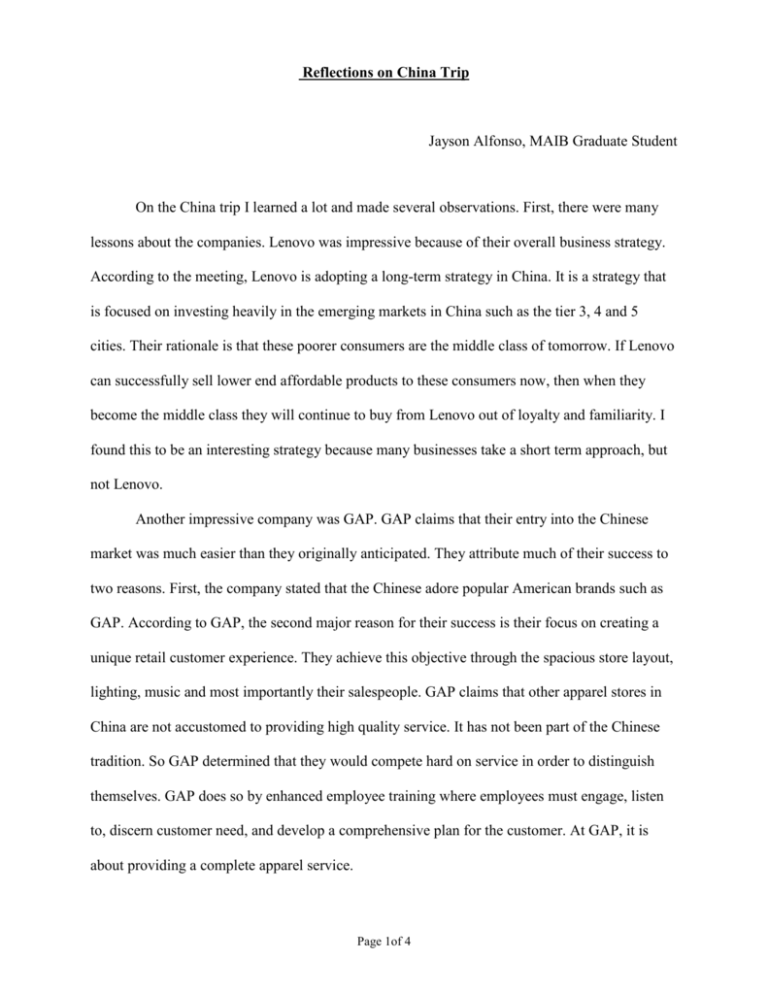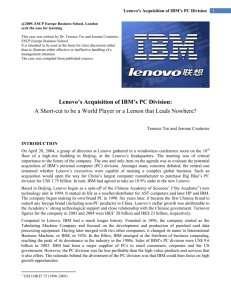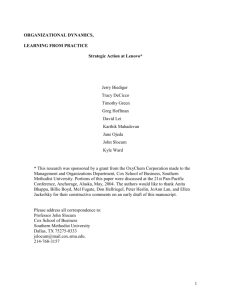Project eight - Faculty, Student & Ph.D. Support
advertisement

Reflections on China Trip Jayson Alfonso, MAIB Graduate Student On the China trip I learned a lot and made several observations. First, there were many lessons about the companies. Lenovo was impressive because of their overall business strategy. According to the meeting, Lenovo is adopting a long-term strategy in China. It is a strategy that is focused on investing heavily in the emerging markets in China such as the tier 3, 4 and 5 cities. Their rationale is that these poorer consumers are the middle class of tomorrow. If Lenovo can successfully sell lower end affordable products to these consumers now, then when they become the middle class they will continue to buy from Lenovo out of loyalty and familiarity. I found this to be an interesting strategy because many businesses take a short term approach, but not Lenovo. Another impressive company was GAP. GAP claims that their entry into the Chinese market was much easier than they originally anticipated. They attribute much of their success to two reasons. First, the company stated that the Chinese adore popular American brands such as GAP. According to GAP, the second major reason for their success is their focus on creating a unique retail customer experience. They achieve this objective through the spacious store layout, lighting, music and most importantly their salespeople. GAP claims that other apparel stores in China are not accustomed to providing high quality service. It has not been part of the Chinese tradition. So GAP determined that they would compete hard on service in order to distinguish themselves. GAP does so by enhanced employee training where employees must engage, listen to, discern customer need, and develop a comprehensive plan for the customer. At GAP, it is about providing a complete apparel service. Page 1of 4 For example, if a customer comes in looking for a shirt. A GAP employee must go beyond a simple greeting and guidance to shirt section (service model for other apparel companies). A GAP employee must not only show the customer the shirt but should also help the customer assemble suitable outfit. So they would suggest jeans and perhaps a belt to go with the shirt. GAP believes that this type of service helps keep their customers happy and will cause customers to remain loyal to GAP. Wal-Mart is another successful company. They have managed to divide the Chinese market into different categories of consumers by income. Their list includes A, B, C, D and E income level consumers. Based on this information they have designed a unique store format for each consumer type. For example, for the A consumer group (high income) Wal-Mart has established highend Sam’s clubs. For the lower socio-economic groups (C, D, E), Wal-mart has installed discount compact hyper stores and soft discount stores in the poorer neighborhoods. These stores are similar to convenient store formats. Wal-Mart believes that rather than big box stores, these types of small mom and pop formats will be more attractive to the lower socio-economic groups. These groups are accustomed to bargain shopping at small outdoor markets and therefore, Walmart believes there will be smooth transition to their convenient store format. Thus, Wal-Mart has a system where they create a different store format for each class of customer due to China’s diverse consumer base. Wal-mart is also successful because they have a localized product selection. They make their decisions based on what locals want. In Shenzen, the locals enjoy Alligator Tail. So Wal-mart offers it in Shenzen but not in the United States. Home Depot is yet another fascinating story. Home Depot entered the China market with several stores. Today, they have closed most of their stores and left China for the most part. Many believe that Home Depot represents a business case about how not to do business in China. According to the sourcing manager for Lowes Asian division, Home Depot did not do Page 2of 4 well because they did not understand Chinese culture. Home Depot tried to force their “do it yourself” model onto the Chinese people but they rejected it. They prefer a “do it for me” service oriented business. When I asked a young Wal-mart representative named Ana Lee for the reason behind this preference she had some interesting comments. She stated that the older generation came from a poor agricultural background. So they are very money conscious. They would rather save money and time by hiring cheap labor to do a home improvement project. This allows the Chinese to spend their time working and making money or on leisure. She also stated that this philosophy could change as the youth in China (herself included) tend to imitate some Western behavior. They have more disposable income (because they live at home) and do not save as much as their parents. They spend more and are more likely to be willing to try a “do it yourself” project if they like the product style. She also said the store would also need parking or home delivery so that the materials could be transported to her home. Based on these meetings, it seems as though Home Depot had bad timing and may have entered too early. If they wanted to stay however, they may have to add more services to their model and less do it yourself. They could also wait until the younger generation increases as a proportion of the population, then enter the market and sell to these consumers. I also learned a few lessons about the Chinese culture. The Chinese place a high value on family. The grandparents are very important and involved in raising the grandchild. The elder are typically cared for by the younger generation. This dynamic could prove problematic as the onechild policy continues to cause a growing disparity between the younger population numbers and the older population. If there are fewer young people then the pressure for them to support their families could go up and reduce their disposable income. This change could affect consumption as well. So the one-child policy could change to avert this problem. Page 3of 4 Another impressive aspect of the Chinese culture is their ability to make things happen quickly. We learned that the Chinese government creates 5 year plans and then executes on them at incredible speeds. So they are able to develop infrastructure and public services and fast rates. This could be an advantage for the country as they attempt to service a fast growing population. Page 4of 4







